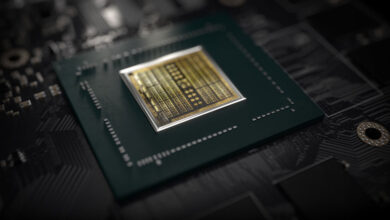
XPG entered the affordable PSU market with the Pylon series. The smallest member of the line has 450W capacity and is our peak for this category, from when Corsair decided to withdraw the CX450 model, which used a modern but expensive platform, making it hard to keep its price low. From the moment the CX450 is out of the equation, the road is open for the XPG Pylon 450 to shine.
At just $50, it’s also one of the cheaper PSUs worth your cash today, hence why it’s one of the best power supplies for gaming today.
Specifications
(Image credit: Future)
(Image credit: Future)
(Image credit: Future)
Technical
Manufacturer (OEM)Channel Well TechnologyMax. DC Output450WEfficiency80 PLUS Bronze, Cybenetics Bronze (82-85%)NoiseCybenetics A- rating (25-30dB[A])ModularNoIntel C6/C7 Power State SupportYesOperating Temperature (Continuous Full Load)0 – 50°CProtectionsOVP, UVP, OPP, OCP, OTP, SCP, surgeNo Load OperationNoCooling120mm Fluid Dynamic Bearing Fan (HA1225M12F-Z)Semi-Passive OperationNoDimensions (W x H x D)150 x 85 x 140mmWeight1.7 kg (3.75 lb)Form FactorATX12V v2.52, EPS 2.92Warranty5 Years (3 years when purchased before 2022 January)Price$50
From 2022, XPG upgraded the warranty on all Pylon models to five years to keep up with the competition. Given the fluid dynamic bearing fan and the reliable platform provided by Channel Well Technology, the warranty upgrade makes sense. The significant compromise that had to be made to keep the cost down was the use of an outdated platform, which, however, has DC-DC converters for the generation of the minor rails and the non-modular cables.
The platform uses a mix of older and newer design techniques. The double-forward topology on the primary side is outdated; the same goes for the SBRs used for the 12V rectification on the secondary side. The modern touch is the DC-DC converters for generating the minor rails, which boosts efficiency. The bulk cap is of high quality, but its voltage rating ideally should be higher, at 420V. The electrolytic caps on the secondary side are of Elite, so they are of good quality, and the same applies to the Hong Hua FDB cooling fan.
Power
Rail3.3V5V12V5VSB-12VMax. Power (amps)202037.52.50.3Max. Power (watts)10010045012.53.6
The 12V rail can deliver the unit’s full power, while the minor rails can deliver up to 100W combined.
Cables
CableAmount includedIn-cable capsATX Connector 20+4 pin1No4+4 pinEPS12V1No6+2 pin PCIe2NoSATA3 / 1NoSATA / 4-pin Molex / FDD2 / 1 / 1NoAC Power Cord1N/A
All cables are fixed for a lower cost. The ATX and EPS cables are long; the same goes for the PCIe and peripheral cables. Lastly, the distance between the latter is adequate at 150mm.
Performance
(Image credit: Future, Cybenetics)
(Image credit: Future, Cybenetics)
(Image credit: Future, Cybenetics)
(Image credit: Future, Cybenetics)
(Image credit: Future, Cybenetics)
(Image credit: Future, Cybenetics)
(Image credit: Future, Cybenetics)
(Image credit: Future, Cybenetics)
(Image credit: Future, Cybenetics)
(Image credit: Future, Cybenetics)
(Image credit: Future, Cybenetics)
(Image credit: Future, Cybenetics)
(Image credit: Future, Cybenetics)
(Image credit: Future, Cybenetics)
(Image credit: Future, Cybenetics)
(Image credit: Future, Cybenetics)
(Image credit: Future, Cybenetics)
(Image credit: Future, Cybenetics)
(Image credit: Future, Cybenetics)
(Image credit: Future, Cybenetics)
(Image credit: Future, Cybenetics)
(Image credit: Future, Cybenetics)
(Image credit: Future, Cybenetics)
(Image credit: Future, Cybenetics)
The load regulation is tight on all rails and the ripple suppression is excellent.
The hold-up time isn’t long enough to meet the ATX spec’s requirements, but this is common in the budget PSU category because the bulk caps are among the most expensive parts in a PSU. That said, the hold-up time is only 0.1 ms away from the goal, with the power ok signal’s hold-up time being 1.3ms lower than the limit.
Typically, the inrush current is way higher with 230V input.
The double forward topology on the primary side doesn’t allow for higher efficiency levels. The PSU cannot exceed 60% efficiency with a two-percent load, which is required by the ATX spec.
From the graphs it’s clear the 5VSB rail is highly efficient, and the PSU’s energy needs on standby are minimized.
The transient response is mediocre at 12V, decent at 5V, good at 5VSB, and terrible at 3.3V, where most PSUs of the same category don’t achieve good results.
On to protections and the Over Current Protection’s triggering points at 12V are correctly set, and the same goes for Over Power Protection (OPP). On the other hand, the 3.3V rail’s OCP point could be lower.
The relative performance is high, losing only to the Corsair CX450 and the Asus TUF-450B, which use the same platform provided by Great Wall. The CX450 also used a CWT platform since Corsair decided to proceed with two OEMs for the CX line with similar spec platforms.
The average efficiency is in about the middle of this category, yet this is not a noisy PSU.
Final thoughts
(Image credit: Future)
With the (more expensive) Corsair CX450 out of the game, the XPG Pylon 450 is one of the best choices in the low-capacity category, offering good performance and increased reliability thanks to the proven CWT platform that it uses and compact dimensions.
The non-modular cable design won’t please most users, but modular cables would notably affect the final price, so they had to go to. Given the not-so-high number of cables in this PSU, because of its low capacity, the non-modular design won’t be a significant issue. Lastly, the five-year warranty that XPG provides is the cherry on top of this product.
If you can’t pick up this PSU in your area, you might want to look out for the Asus TUF-450B-Gaming instead. This PSU also performs very well in testing.





